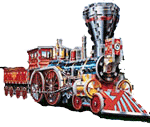Steam Locomotive

test
Work on the railroad unfolded at breakneck pace, over a course that was improvised by explorers on horseback, compass in hand. In 1869, these bold pioneers complete the first US transcontinental railroad at Promontory Point, Utah.
The train, which truly revolutionized transportation, spelled the end of the stagecoach, whose 20 km/h (12 mph) were no match for an imposing machine capable of reaching speeds of 100 km/h (62 mph). This type of locomotive made those who built it proud, and those who traveled the US, aboard it also shared in that pride.
This esthetically polished locomotive housed the main technical features that would drive steam engine technology for over a century: front horizontal stack and cylinders, drum-like body in the middle, tubular boiler, firebox and cab at the back. The tender attached to the locomotive carried the wood and water required for the boiler. The advent of this new means of transportation went on to impact the country’s economic development considerably.
